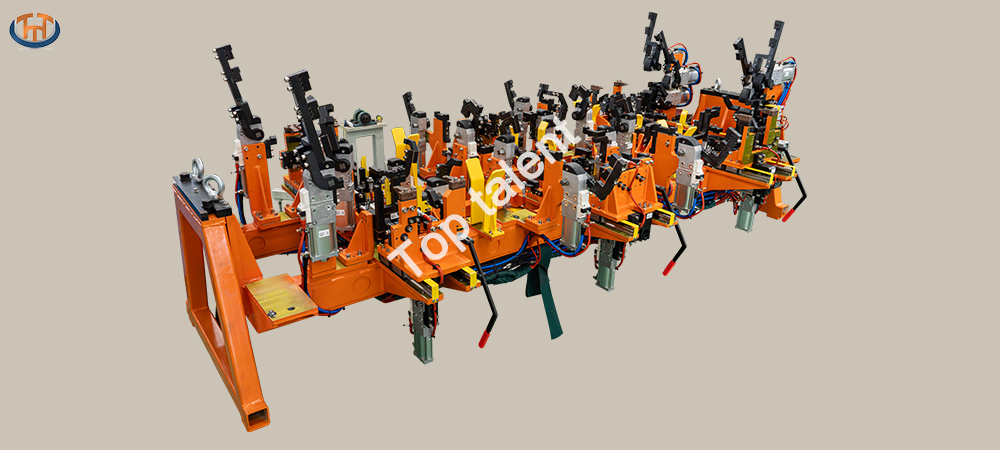In the thunderous symphony of an automotive assembly line, where sparks fly and metal fuses, one critical player often operates in the shadows: the arc welding fixture. More than just a holder, these sophisticated jigs are the unsung heroes ensuring the structural integrity, dimensional accuracy, and consistent quality that define modern vehicles. Understanding their role reveals the precision engineering behind every safe and reliable car or truck.
Beyond the Clamp: The Critical Role of Fixtures
At its core, an arc welding fixture is a specialized workholding device designed to precisely locate, support, and clamp automotive components – body panels, subframes, chassis members – during the welding process. But its function is far more profound than simple positioning:
Pinpoint Accuracy: Fixtures guarantee components are held in their exact, pre-determined positions. This eliminates human error in alignment, ensuring every weld joint is exactly where the CAD model specifies. This is non-negotiable for complex assemblies like BIW (Body-in-White), where millimeter-perfect alignment is crucial for fit, finish, safety, and downstream assembly.
Minimizing Distortion: The intense heat of arc welding causes metal to expand and contract. Fixtures act as a heat sink and provide rigid constraint, strategically clamping components to counteract these thermal forces. This dramatically reduces warping and distortion, saving costly rework and ensuring components meet stringent dimensional tolerances.
Consistency is King: Whether it’s the first unit off the line or the thousandth, a well-designed fixture ensures identical component placement every single time. This repeatability is fundamental for mass production, guaranteeing uniform quality and performance across the entire vehicle run.
Enabling Automation: Modern automotive manufacturing thrives on robotics. Welding fixtures are the essential interface between the robot and the workpiece. They provide the stable, predictable platform robots need to execute complex weld paths with speed and precision, maximizing uptime and throughput. Robotic welding fixtures are engineered for seamless integration with automated cells.
Operator Safety & Ergonomics: Fixtures securely hold heavy or awkward components, reducing strain on operators and minimizing handling risks. They position the weld joints optimally for safe access, protecting workers from sparks and heat.
The Evolution: Smarter, Lighter, More Flexible
Today’s automotive welding fixtures are feats of engineering, evolving beyond simple clamps:
Modular Design: Utilizing standardized components allows for faster fixture build times and easier reconfiguration for model changes or variations, enhancing manufacturing flexibility.
Lightweight Materials: Increased use of aluminum alloys and composite materials reduces fixture mass, making them easier to handle and manipulate, especially within automated lines.
Advanced Clamping: Hydraulic, pneumatic, and electric servo clamping provide precise, repeatable force application and faster cycle times. Self-locking mechanisms enhance safety.
Integrated Sensing: Sophisticated fixtures incorporate sensors (probes, proximity switches) for in-process verification. They can detect if a component is fully seated before welding commences or confirm clamp closure, preventing errors and ensuring process integrity.
Adaptability: As vehicles incorporate more aluminum (especially in EVs) and advanced high-strength steels (AHSS), fixtures are designed to handle these materials effectively, often requiring different clamping strategies and thermal management.
Data Connectivity (Industry 4.0): Fixtures are becoming data nodes. Sensors can feed clamp status, cycle times, and verification data into MES (Manufacturing Execution Systems), enabling real-time monitoring, predictive maintenance, and traceability.
The ROI of Precision Fixturing
Investing in high-quality, well-engineered arc welding fixtures delivers significant returns:
Reduced Scrap & Rework: Minimized distortion and guaranteed accuracy mean fewer defective parts.
Increased Throughput: Faster clamping cycles, seamless robot integration, and reduced downtime boost production rates.
Enhanced Quality & Safety: Consistent, dimensionally accurate welds translate directly to vehicle structural integrity and crashworthiness.
Lower Labor Costs: Automation compatibility and ergonomic design reduce direct labor requirements and strain.
Faster Model Changeovers: Modular designs shorten retooling times.
Conclusion: The Foundation of Structural Integrity
While the welding robot grabs the spotlight with its dazzling arc, the arc welding fixture is the indispensable foundation. It is the silent guarantor of precision, consistency, and quality in automotive manufacturing. As vehicles become more complex, lightweight, and safety-critical, the demands on these fixtures only grow. They are not merely tools; they are the meticulously engineered bedrock upon which the structural soul of every modern automobile is reliably built, weld by perfect weld. Choosing and designing the right fixture isn’t just about holding parts – it’s about building in quality from the very first spark.
Post time: Jul-18-2025



.png)
.png)